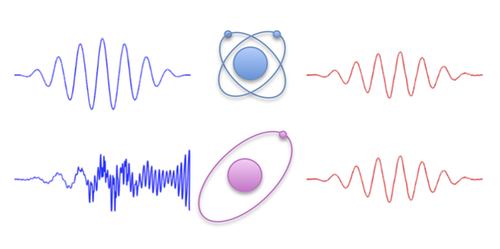Atomic Impersonator
Every atom or molecule has a characteristic spectrum that it emits when excited by light. But this “chemical fingerprint”—it turns out—can be forged. Theoretical work demonstrates that tailoring an incoming light pulse can make a single atom of hydrogen, for example, emit a signal that mimics that of argon. The work demonstrates a new degree of flexibility available for controlling the quantum states of atoms. The theoretical approach could eventually lead to solutions to a related, reverse problem: how to discriminate between two molecules that have very similar spectral features.
Researchers often use light to make atoms and other systems behave in an unusual way. This so-called quantum control can, for example, steer a set of chemical reactions to yield more of a desired molecule than would be produced without the light. Another application is in high harmonic generation (HHG), where a strong light pulse excites a gas of atoms and causes them to emit at a series of frequencies that are much higher than normal [1]. Calculating the complicated, time-dependent input light pulse that optimizes HHG emission is computationally intense, so theorists have tried calculating the pulse shape analytically using approximations. But so far there is no general solution.
A team of theorists from Princeton University led by Herschel Rabitz tackled the problem of controlling the light emission from an atom using quantum control. Unlike previous attempts to calculate the required excitation pulse, where theorists dealt with a finite number of atomic states, the Princeton team's model assumes that the incoming light pulse could excite the atom into one of an infinite number of states. Some of these states are ionized states, in which an electron is freed from the atom but only temporarily. By incorporating this broader range of states, the team realized that they could control the quantum state of the atom in practically unlimited ways.
In particular, the model implied the possibility of atomic impostors. We usually think of spectral signatures as unique—an astronomer, for example, infers the presence of argon in a star based on its spectrum. “But it could be a little green man with a fancy laser trying to mislead us by making hydrogen atoms look like argon atoms,” says team member Denys Bondar. Although such extraterrestrial trickery is unlikely, the Princeton team showed that it is possible to hit any atom with a specially crafted laser pulse and make it look like any atom you choose.
As a first demonstration, the researchers used the Schrödinger equation—one of the basic equations of quantum mechanics—to calculate the pulse shape that would distort a hydrogen atom's electron cloud in such a way that it would emit an argon atom's spectrum. In other examples, the team imagined a classical electron orbiting the nucleus and obeying Newton’s equations, rather than Schrödinger’s equation. Surprisingly, even in this impossible situation, there is a laser pulse that can make the system emit as if it were a normal (quantum) atom. The implication is that it really doesn’t matter what the light-interacting material is—you just need to be able to drive nonlinear, light-matter interactions that can amplify certain emission frequencies while suppressing others. Creating the necessary nonlinear interactions requires strong laser pulses with sufficient bandwidth, which is doable with modern optics, says team member Andre Campos.
The team’s methods could be applied not only to optimizing HHG emission but also to other problems in quantum control, says the team. For example, in “optimal dynamic discrimination” (ODD), the goal is to distinguish two fluorescent proteins or other molecules that have roughly identical spectra. The Princeton group is currently investigating ways that their mimicry calculations could be used to amplify small differences in the two objects and allow their induced light emissions to be easily discriminated from one another.
Quantum control expert Tim Freegarde, from the University of Southampton, UK, says the new work is “intriguing” in its description of the capabilities of light-atom interactions, but he questions whether the strong pulses needed would be practical for biological samples in ODD. Kurt Jacobs, a theorist specializing in quantum measurement at the U.S. Army Research Laboratory in Adelphi, Maryland, envisions controlling atoms for other discrimination problems. “It may be possible to harness the nonlinear dynamics of even a single atom to perform complex information processing tasks such as speech recognition,” where similar words must be distinguished, he says.
This research is published in Physical Review Letters.
–Michael Schirber
Michael Schirber is a Corresponding Editor for Physics Magazine based in Lyon, France.
References
- C. Winterfeldt, C. Spielmann, and G. Gerber, “Colloquium: Optimal Control of High-Harmonic Generation,” Rev. Mod. Phys. 80, 117 (2008).





